

GREAT BRITISH SPORTS CARS
Lotus Esprit
Colin Chapman ‘s flair and vision produced
the remarkable Lotus Esprit 21 years ago.
Though impaired by cash problems, it grew into one of the true greats. Says
Tony Dron
As a driver, it’s hard not to love this car in true Lotus tradition it
became a great driving machine, with extraordinary roadholding and an unusual
subtlety of handling. There’s a strong feeling of real racer about it.
It’s incredible that it came into being at all In the early Seventies, Lotus dropped all its established models to move upmarket with the totally new Elite, Eclat and Esprit, all to be powered by new all-Lotus engines. The idea was to produce a range of supercars at bargain prices by employing modern manufacturing methods.
As Lotus got stuck into the practical work of this very ambitious new era in its history, it became increasingly clear that the new generation of cars would have to cost much more than planned. Meanwhile, income was interrupted and, with the general economy far from healthy, Lotus was frequently on the edge of financial disaster through those years. Only the determination of Colin Chapman and his team kept the company alive. After launching the Elite and Eclat in 1974 and 1975, they had great difficulty in finding the means to turn the third new model, the Giugiaro-designed Esprit, into a practical road car but the Italian stylist’s personal commitment helped to keep the project moving.
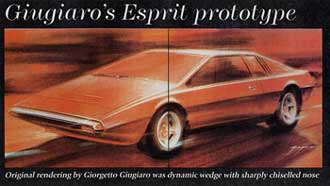
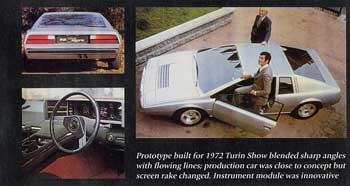
Against the odds, they made it For once, a fantasy show car was put into production: Giugiaro’s styling exercise appeared at the 1972 Turin Show and the production version was unveiled in late 1975. We know now that early cars were inadequately developed but the Esprit was on the road, Effective development and inspired restyling over the years allowed it to endure.
There’s more to this than looks. A key point of the lasting appeal of the Esprit must be the mixture of passenger car engineers and race team personnel who worked on it. This produced a remarkable machine — but not, for sure, without some (well glossed over) internal technical arguments in the early years.
The Esprit had its faults but from the start it had the vital ingredient of being exciting both to those within the factory and to the world outside. In the gloomy days of the mid-Seventies it was invigorating to see such a fresh, boldly executed, utterly modern sports car.
It was very close to Colin Chapman’s heart: he was determined to produce it, whatever problems Lotus faced. When DeLorean wanted to buy Lotus, the other -models were discussed but the Esprit was always to be excluded so that Chapman could continue to make it.
By the late Seventies, however, Lotus cars were selling reasonably well and the Formula One team was on top of the world. It’s just a pity that Chapman ever met John DeLorean, let alone got involved in saving his ludicrous 2 motor car from the perdition it deserved.
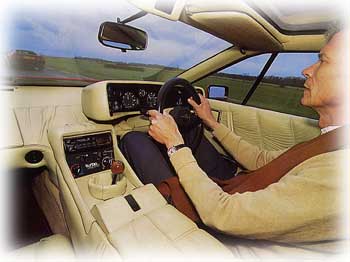
‘Lofty’
Dron does fit into Giugiaro Esprit, but only just: here he is at the wheel
of Chris Cole’s smart Turbo.
There’s much more room in post-1987 cars.
BEHIND THE WHEEL
Before anything else is said, let’s be clear about one thing the Lotus Esprit became one of the greatest drivers’ cars ever made for the road. That is the simple truth of it. Early Esprits were sensational but it wasn’t as easy to put a motor show dream car into production as Colin Chapman probably thought. The essentials were fabulous but a part-finished prototype car was put on the market to get some money back before the company went under. The dream was strong enough to make you want to love it but it was a while before Lotus managed to eliminate the nightmare element.
When the new Esprit first arrived it was considered interesting but not fast enough to deserve the tag of ‘supercar’. The lack of performance is often overstated: to put it in perspective, the standstill to 60mph accel-eration time recorded in Motor’s Road Test of 1977 was 7.5 sec and, though maximum speed was not measured, the magazine stated: ‘Over 130mph is probably feasible.’ True, these are not supercar statistics but they’re hardly slow. Performance figures for the cheaper Triumph TR6. regarded in the Seventies and since as a fast and powerful ‘real man’s car’, were 117mph and 8.5 sec. Barry Ely’s Commemorative S2, seen here, certainly did not feel slow on the road to me.

Our
cover car, John Roberts’ S1 Esprit; note very Seventies trim and Giugiaro
badge. Most S1 cars went to the US.
Engine cover was only fitted to Series 1 cars; Wolfrace alloy wheels were
also unique to the early Esprit.
The earliest Esprits had phenomenal roadholding and simply astonishing traction but the steering feel was below Lotus standards: worse, the noise was enough to drive you mad, and there were several other problems. But few British drivers ever experienced an SI, as virtually all of them went abroad. Fortunately, the energy within Lotus was such that the Esprit rapidly became good enough to own and live with.
Performance was steadily improved: the normally aspirated 2.2 achieved 0-60mph in 6.5sec, with an estimated 135mph top speed: and the original Turbo managed 5.6sec, with a claimed 152mph maximum.
The Esprit was greatly improved but some inherent faults remained even with the introduction of the S3 and Turbo: these were mainly bad visibility, especially to the rear, a poor heating and ventilation system (despite many attempts, it took a very long time to get it right), reflections on the screen (worse with lighter interiors), small pedals which were too close together (excellent if you choose the right shoes before getting in) and lack of headroom for very tall drivers. Unusually elongated folk are more comfortable in the earlier cars, which don’t have that extra ventilation outlet by the left knee. Drivers of normal human dimensions find Esprits comfortable, however, and while there are more practical and civilised supercars from that era, for pure driving pleasure the Esprit is a match for any and better than most.

James
Bond stardom
The experience of handling a mid-engined car with its engine mounted longitudinally is rare enough: in an Esprit, the sense of balance, surefootedness in the wet and feeling of control when driving fast are strong sources of pleasure. You need to be something of an expert to explore its high roadholding limit — but only because it is so high. The ride is unusually good, too: with no lump of engine ahead of you, it’s uncanny the way the front wheels handle bumps and irregularities in the road. Lotus was always superb at showing that lightweight, pure sports cars can be made to ride well and the Esprit is an outstanding example.
Try to put aside any prejudice against four-cylinder engines. The brand-new 1996 V8 unit looks magnificent and will, no doubt, lift the Esprit into an even higher league — but, equally without doubt, it will cost rather more as well. The four-pot engines in all previous Esprits, normally aspirated and turbocharged, are admirably light, efficient and enjoyable to use, if noisy.
Furthermore, the Turbo has unexpectedly excellent torque from low rpm, with no sense of a ‘step’ in the curve as the turbo ‘comes in’; yet all Esprit engines are happy at high engine speeds, too. Before electronic engine management was mastered the quickest Turbos were rather ‘fussy’ but all blown Esprits are firmly in the supercar performance league: the early Essex of Paul Dewey, Graham Bedwell’s dry-sump model and Chris Cole’s slightly later car all reminded me of that fact. They are real road rockets.
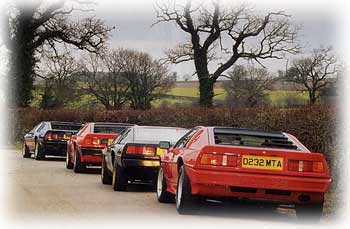
When we were invited to visit the Lotus factory, to photograph the cars in an appropriate setting, we were joined by Lotus engineer James Grantham with his LHD Esprit from 1986, originally a US-spec test car. He bought it some years ago and converted the engine to UK spec. It’s one of the first with the Renault gearbox. which replaced the old SM unit; it also has outboard discs. James says: “It always amazes when I get back into it and drive. There’s so much in reserve.
He’s right. All the owners agreed that you get used to the restricted visibility and other negative points listed in the road tests. Once you get behind the wheel it’s genuine supercar pleasure at bargain price. Everything that really matters is evident: serious performance. great steering, incredible roadholding. powerful brakes with good feel, an unexpectedly good gearchange and the lithe feel of a well-sorted racer. It’s not a ‘sensible’ car: it’s an escapist’s dream, and a fine one, too.
Fuel consumption is good for a Seventies car of such immodest performance: in the region of 18-23mpg under hard use but 25-30mpg is easily achievable. The normally-aspirated models. naturally, tend to be the ones at the less thirsty ends of these ranges.
Don’t worry about the smell of resin remarked on in some road tests. The bodies have fully cured now and there’s no trace of any such odour. With the new body of 1987, visibility, headroom and other longstanding flaws were substantially dealt with. It was a successful reworking of the classic Esprit, recognised as one of the greatest road driving machines. I it again... It’s true.
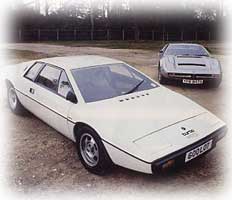
Early
Esprit Turbo with Maserati Merak,
also by Giugiaro; other rivals were Ferrari 308GTB and Porsche 91 1SC Sport.
Try getting a 308 now for price of Esprit...
DESIGN
Lotus racing cars had long been mid-engined when the Europa appeared as the first such Lotus road car in 1966. The idea was to offer an exciting level of technology to enthusiasts at well below supercar prices. The basic design of the Esprit, with a steel backbone chassis and in-line mid-engined layout, may have been broadly similar but the overall concept was quite different. Aiming for the big league, the Esprit was therefore 13ft 9in long and 6ft 1in wide, making it 7in longer and no less than 9in wider than the Europa. Furthermore, the exotic Esprit was styled by the rising Italian star, Giugiaro.
The Esprit’s chassis differed from the Europa’s in that the backbone stopped behind the seats. In place of ‘tuning fork’ extensions to carry the engine, the Esprit chassis was joined to a tubular structure at the rear. The rear suspension, with fabricated radius arms, single lower links and fixed-length driveshafts, was partly mounted on the gearbox. It was low in weight but it transmitted noise and vibration to the interior. Spherical joints were used in the rear suspension in the first few cars but that proved unsatisfactory: bushes more suitable for road use were adopted and all the cars were subsequently converted. Double wishbones were used at the front, which was based on Opel Ascona parts.
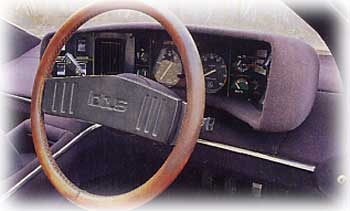
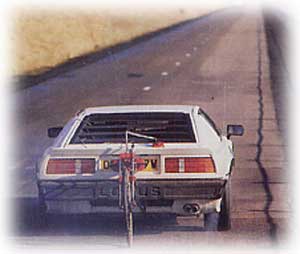
Long-term supplies of the so-called transaxie gearbox/final drive from the SM were secured from Citroen; a good move, as Lotus could not have afforded to develop its own transmission. Crafty machining enabled the inboard rear brakes to be fitted, too; the discs were solid all round, with no servo-assistance at first, though that was changed before long.
Lotus built its own engines at last, moving upmarket and away from the old kit car image. The Esprit was always intended to be offered with a choice of in-line four and V8 engines. For financial reasons, the V8 Lotus engine did not materialise until this year. By the time the Esprit arrived, the slant-mounted four-cylinder, double-overhead-camshaft, aluminium engine was well proven in earlier cars. As first installed in the Esprit in 1,973cc form, it ran on twin Dell’Orto carburettors and produced 160bhp at 6,200rpm, with maximum torque of 140lb ft at 4,900rpm. Although this equated to the efficient little motor delivering an impressive 81bhp/litre, it could hardly be expected to be enough to enable the Esprit to stand alongside the Ferraris, de Tomasos, Lamborghinis, Maseratis and Porsches that it had been intended to challenge.
Tony Rudd, Lotus’s engineering director at the time and one of those charged with turning the Esprit from showtime dream into practical reality, recalls running a prototype Esprit V8 on long-term test in the Seventies: “Four litres and over 300bhp really lifted the car but it tended to demolish second gear or break the diff. When Lucas demanded payment for fuel injection development we tried Webers but suffered fuel surge in corners.” Lotus just didn’t have the money to finish the job: with reluctance it had to drop it in 1979 and pursue an alternative path to true high performance. By then the car had been in production for three years.

Above,
visibility a serious problem with early Esprits but these slats, considered
stylish at the time, did not hinder rearward vision.
Lotus soon on top of world again after Esprit launch with Fl wins (above,
Barry Ely’s Commemorative S2)
From the start, Esprit bodies were made in two halves, joined at the waistline, but further problems in 1976 had meant that the early ones could not be made by the celebrated vacuum (VARI) system and were laid up by hand. When the factory was able to go over to VARI, the Esprit put on unexpected weight and, Tony Rudd recalls, “There was a bit of a lull while that was sorted out.”
The first big change came with the S2, announced in August, 1978. The main features were wider wheels, a bigger radiator with improved airflow (but that took some months to reach production) and ducts behind the rear windows (nearside fed the carb and demisted the rear window; offside cooled the engine bay).
An engine enlargement to 2.2 litres, announced in May 1980, increased the peak torque to 160lb ft at 5,000rpm and gave a useful performance improvement. Also announced in 1980, after the forced abandonment of the V8, the Turbo brought real performance at last. This engine had been developed successfully and more cheaply in parallel with the ill-fated V8: the Garrett turbocharger drove through smaller twin Dell’Ortos and the fully redeveloped engine produced 210bhp. Early Turbo engines had dry-sump lubrication.
The rest of the car was substantially re-engineered, too, and the normally-aspirated Esprit S3 of 1981 shared the main benefits of this. There were changes to the appearance but the most important developments were under the skin: a galvanised chassis with a wider front box section and suspension mounting points; new engine mountings to reduce vibration; pure Lotus parts to replace the Opel elements in the front suspension; improved rear suspension with lower wishbones and a new upper link. Designed for the V8, the production Turbo was, frankly, over-engineered by Lotus standards. Torsional rigidity was well up, vibration was down and there was a claimed, and much needed, 50% reduction in noise inside the car. Relieving the driveshaft of having to function as the upper rear suspension link gave an additional reduction in transmitted harshness.
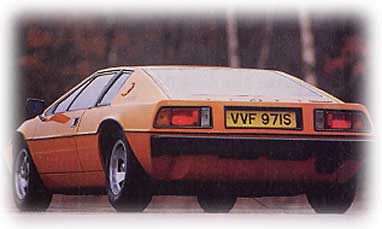
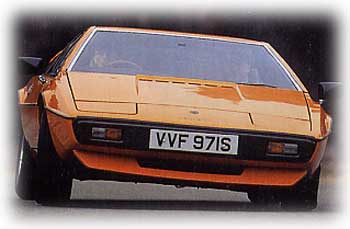
When
Esprit first arrived (S1, below) it wasn’t considered deserving of ’supercar’
tag - but 0-60 in 7.5sec was hardly slow
These changes, lavish new trim and luxuries such as electric windows all cost money, so that, at £20,900, the Turbo Esprit was actually more expensive than the rival Ferrari 308GTB, Porsche 911 SC Sport and the rest — but it was also, at last, the quickest among them.
Maximum power went up to 215bhp in 1986 when the High Compression turbo engine was introduced but the increase in torque at lower rpm was greater. Development went on without cease through the good times and the bad.
Giugiaro’s classic styling was replaced in October 1987 by a completely new, more rounded Esprit body, brilliantly styled in-house by Peter Stevens. In 1989 charge cooling and electronically controlled fuel injection boosted power to 264bhp in the sensationally quick Turbo SE. That’s all recent stuff; but it’s worth stating that the current Esprits are by far the best: noise, vibration and harshness have been transformed, while drivers of almost any size can feel comfortable. The transmission is now Renault, and modern electronics and power systems abound.
The Esprit has been a true supercar for many a long year and the arrival of the exciting new V8 completes the original design intention at last, in a vastly more sophisticated manner than originally envisaged. The charm of the early cars endures, especially from the 2.2 onwards, and they remain the supercar bargains of the century in the classic-car market.
|
Books about the Esprit began to appear in the early Eighties. There was Lotus Esprit by Jeremy Walton, published in 1982 by Osprey Motorbooks International, then came The Third Generation Lotuses by Graham Robson in the MRP Collector’s Guide series in 1983. Walton brought his story up to date in 1991 with Lotus Esprit, The Complete Story from Crowood Autoclassics and, in 1993, Robson updated his Collector’s Guide, splitting it into two volumes: Volume 2 is devoted entirely to the Esprit. Most owners will want Lotus Esprit by Gerard Crombac, published by Automobilia of Milan. Crombac, a longstanding trusted friend and client of Chapman’s Lotus Cars, is tremendously informative and a good general history of Lotus is included but the English text is appalling, to the point of being incomprehensible or misleading in places. Linguists may get more out of it, since the copy is triplicated, in French and Italian as well as the crypto-English. It’s a good book despite this. Respected by owners, too, is Lotus Esprit Turbo by John Simister, from Salamander in 1989, published by Mallard Press in the USA and translated into German by Verlag Stocker-Schmidt. It’s not strictly Esprit but you might consider Lotus: All the Cars by Anthony Pritchard, from Aston Publications, 1 990: it’s an excellent overall survey, though the captions are poor. There are also Brooklands Books road test compilations
which are, as always, well worth having. Now that the V8 is here, it
must be time for some of these writers to think about new editions. |
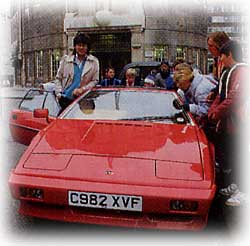
Cor,
look at that motor!” Esprit was a car to be seen in; this
one’s pictured with ex-Radio One DI, Mike Read.
OWNING & RESTORING
People who do not own Lotuses say they are unreliable but the owners of the Esprits shown here all said they have had no trouble. What does this mean? First, there’s no doubting that years ago Lotus frequently put cars into production before they were fully developed, making early customers effectively unpaid test drivers. The firm needed the cash flow to avoid bankruptcy.
The saving graces were always that Lotus cars were exciting to look at, uniquely rewarding to drive and conceived with a fundamentally elegant engineering philosophy. Chapman himself was extraordinarily forward-minded and energetic. He thought fast, lived fast, paid great attention to vital details and hated to waste time on anything irrelevant. He designed all his cars for people like himself.
If you are the kind of person who forgets when your car’s service is due, or deliberately ignores it in the hope that everything will be all right, or can’t be bothered to let a turbocharger cool down before switching off, you should get a Mercedes or a Morris Minor. Don’t buy a Lotus: it’s not for you. When the book says you should change this grommet at 5,000 miles and that bearing at 10,000, it means it. The poor, neglected Mercedes or Morris might roll on despite much abuse but the Lotus will not. Stick rigidly to the service schedule, though, and you should find that your Esprit is as reliable as those featured here: that’s what the owners say, anyway.
Most Esprit owners prefer to rely on professionals to service their cars but there are exceptions. Graham Bedwell enjoys doing his own engine rebuilds and is very good at it, too, if his dry-sump Esprit Turbo is anything to go by. Many home mechanics, accustomed to cast-iron engines, would not take long to wreck a Lotus: excessive torque settings when working on aluminium castings result in stripped threads all round.
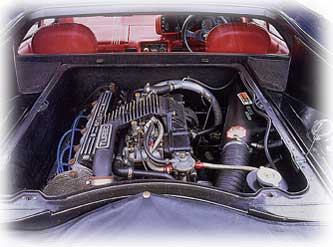
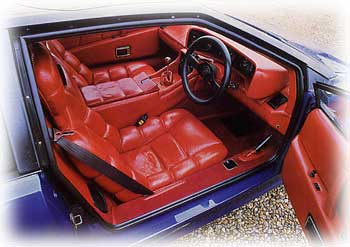
Very
Essex... Paul Dewey’s early Essex Turbo confirms that blown Esprits firmly
in supercar performance league .
Turbo brought real performance at last in 1980, after V8 project abandoned;
210bhp gave 0-60 figure of 5.6sec and claimed 152mph
There are things to watch out for. Some Esprits can catch fire if the carburettors are worn out, allowing fuel to drip on to the distributor with the inevitable result. Service everything when it is due; not one mile later... If you need to replace a windscreen, it is a long, tricky job, best tackled by a Lotus specialist. Much interior trim has to come out and non-experts will almost certainly do some damage. This tip came from Barry Ely, for 12 years the owner of the Commemorative S2 seen here — guess what, it’s for sale and he’s a Lotus specialist in Leyton, East London. To be fair, he points out that screen replacement is not profitable — he just hates to see Lotuses lashed up by bad workmanship and is happy to give free advice to owners (call Barry Ely Sports Cars on 0208 558 3221).
Galvanised chassis were introduced with the S3 and the original Turbo: so far all seem to remain as rust-free as the GRP bodies. Some of the brighter exterior colours have faded but the mouldings seem to be of excellent quality and extremely durable. The bodies of the cars we photographed show no signs of crazing or cracking.
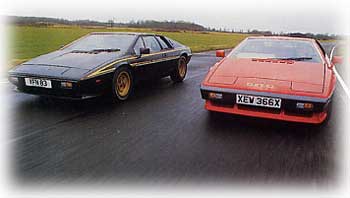
Commemorative
S2 and Graham Bedwell’s ‘dry-sump’ Turbo are ‘at home’
on Hethel factory’s test track in Norfolk
Good factory parts back-up means restoration is fairly easy.
Obviously an Esprit will be more expensive to rebuild than the average classic
but it’s a bargain by supercar standards: the four-cylinder engines are
a lot cheaper than the complex power units of exotic rivals.
By the way, don’t fit silly wheels and tyres, or spacers. Lotus took
care to optimise its original specifications and such nonsense won’t
improve anything.
Wise owners belong to several Lotus clubs, gaining invaluable technical advice and contacts from the most knowledgeable enthusiasts: there are circuit-driving days to be enjoyed, too. One of the best this year should be Silverstone GP Circuit (August 23, Lotus Drivers Club). The cars shown here were located for us by Club Lotus, organiser of many events throughout the year.

Engineer
James Grantham’s LHD ‘86 Esprit (above) was originally a US-spec
factory test car;
he’s converted it to con temporally UK spec. One of first with Renault
gearbox
BUYING AN ESPRIT
For the many reasons given elsewhere in this article, it is worth going for a later car: Lotus really was struggling to survive in 1975-1976 and the relatively undeveloped S1s were, as a result, not that well built. Oddly enough, the market hardly seems to recognise this: a good S1 might fetch £5,000 or more while an early S3 in similar condition might be worth £6,000. A younger S3 HC in superb order might go for twice that much, however Good early Turbos start from about £10,000.
Everyone knows that service history should be checked on any used car. With an Esprit you need to know every detail, so don’t rely on the sight of a fat file of ‘full service history’ documents. I’d read every one, carefully. Where has it been? What went wrong? Was everything really done on time? Has it been to any of the many respectable Lotus specialists recently? If so, ring them up and ask what they know about the car.
S1s and S2s may need driveshaft and rear suspension work. An Esprit that sits low probably needs new springs and dampers. Look for cracked and corroded exhaust manifolds. Check the cambelt on all Esprits (and renew it regardless if you buy the car — failure if it snaps might do £2,000-worth of damage). Listen for transmission whines, as gearbox rebuilds are not cheap. Check the radiators on early Turbos, as unnoticed partial clogging can cause a burnt-out piston at sustained speed.
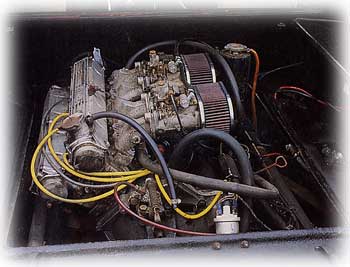

If you can satisfy yourself on all these points, there is no doubt in my mind that it could be worth paying a little over the guideline prices. An early Esprit Turbo is the bargain supercar par excellence in the classic-car market. One of its great rivals when new was the Ferrari 308GTB: see if you can get a decent one of those for 10 grand now... Only the contemporary Porsche 91 ISC Sport comes close in value for money today; some distinctly inferior contemporary rivals mysteriously fetch about twice as much as the Lotus and the (slightly more valuable but magnificently engineered) Porsche.
Buying a used example of any of these cars is a risk. Your first service may cost thousands, so never buy on impulse. An enthusiast I know snapped up an apparent bargain, an Esprit Turbo that had suffered a minor engine-bay fire. In repairing that, it steadily dawned on him that his car had been neglected for years and butchered occasionally by cowboy mechanics. By the time he had finished putting it all right, it looked superb and went very well but he was older and wiser, and his enthusiasm was gone — he went back to Jaguars.
Look around the car to see whether it appears to have received loving care. If it’s a dirty mess with even the odd stripped thread on the engine, be very suspicious. If you can’t find a perfect example of the Esprit you are chasing, a not-so-good one (a restoration case, really) should be easy enough to find at £3,000-£4,000. Do try to be realistic about what it will cost to get it back into the sort of state that will stop poor Cohn Chapman from spinning in his grave.
Don’t forget to check for accident damage before you close a deal. Evidence of a shunt is easy to spot. If you find any signs, get a professional inspection.
Clubs
Club
Lotus
32A High Street
Dereham, Norfolk
NR19 1DR
Tel 01362 691144/694459; fax 695522
Lotus
Drivers Club
Patricia Cowling
9 Boyleston Road
Hall Green
Birmingham B28 9JN
Tel 0121-745 5017; fax 0121-733 6831
Lotus
Owners Club
R Dixon
90 Cappell Lane
Stanstead Abbots
nr Ware
Herts SG1 2 8BY
Tel/fax 01920 877840
Giugiaro
Esprit Group
Mike Maynard
5 Roach Vale
Leigh-on-Sea
Essex SS9 STO
Tel 01702511057
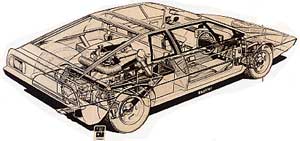
initial Esprit engine; 1,973cc and twin Dell’Orto carbs.
Above, cutaway of early Turbo; rear suspension partly mounted on gearbox.
Lotus Esprit — What Motor Said
Announcing the original Esprit in 1975: ‘...completely new... two-seat mid-engined sports car intended to provide the highest possible standards of roadholding, handling and performance... expected to be in the region of £5,000’.
First Road Test, 1977: ‘Inflation has increased the price to nearly £8,000. Even at this level.., the car is £2,000-£5,000 cheaper than other high-performance sporting cars — supercars the Esprit matches in some respects, not in others’
Esprit S2,1977: ‘In a straight line the Esprit is not as quick as its more expensive rivals like the 911, Dino, Merak or Pantera, but none can corner as fast or satisfyingly as the basically neutral-handling Esprit’.
First Turbo Esprit Road Test, 1981: ‘At last — a Lotus which can compete with real exotica... the urge to go with the image... quite simply, one of the fastest accelerating cars that money can buy’.
S3, 1981: ‘Careful development work has advanced the Esprit to the point where its only major drawbacks are those inherited from the imaginative pen of Mr Giugiaro...’
Esprit Turbo HC in 1987: .., more power to exploit its excellent handling. The flaws remain, but there are few more exciting cars at the price’.
| Model | Year | Production numbers |
| Esprit S1 | 1976-1977 | 718 |
| Esprit S2 | 1978-1981 | 1,060 |
| Esprit S2 2.2 | 1 980-1981 | 88 |
| Esprit S3/Esprit NA | 1988-1990/81-87 | 1,053 |
| Turbo Esprit (inc HC) | 1980-1992 | 2,274 |
| Esprit Turbo HCPI (US model) | 1985-1988 | 881 |
| Esprit Turbo SE | 1988-1990 | 1,608 |
| Esprit S (just Esprit’ in US) | 1990-1992 | 252 |
| Esprit S4 | 1992-1996 | 624 |
| Esprit Sport 300 | 1991-1995 | 64 |
| Esprit S4s | 1992-1996 | 361 |
| Total | 1976-1996 | 8,983 |
• These figures have been produced in conjunction with Lotus Oars and have been checked and approved by the factory. They are certainly close to being accurate but the records are hard to trace in some cases; there have been innumerable specification changes, for example, making it hard to be sure of which model is which in the records; and the figures don’t separate pre- and post-1987 redesign cars at all. Sorting Esprit Turbo from Esprit Turbo HO in the production figures proved just as difficult but we are satisfied these official results are not far out, if at all.
• These numbers will differ from those you will find in the books, partly because they are up-to-date and cover all Esprit four-cylinder production so far. A new era is now beginning with the V8 models.
• Most of the early cars were exported, many to the USA, and it was over a year after the initial announcement before the first Esprits became widely available on the British market. Lotus sales in the States suffered badly in the early Eighties as the company struggled to reorganise its North American operations. Overall, perhaps some 70% of new Esprits went overseas: at least, that is the healthy export rate at which the factory is working today.
|
|